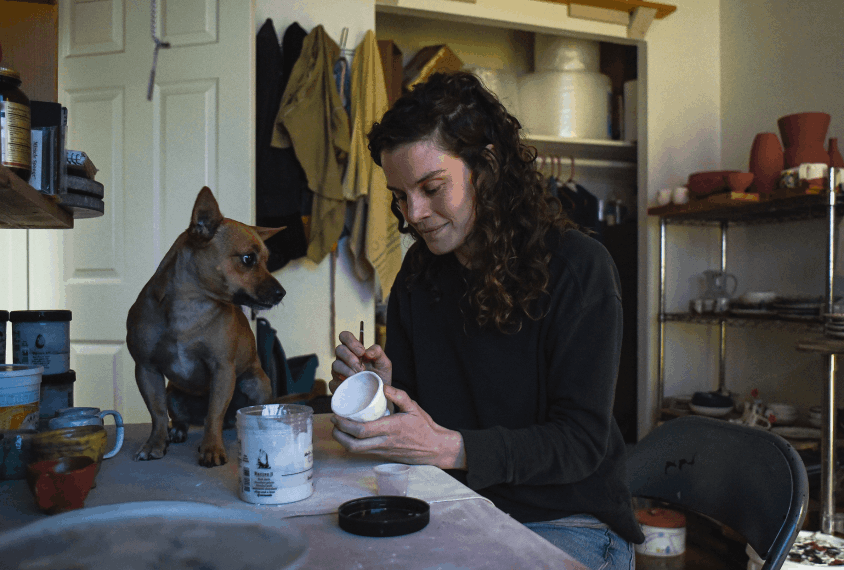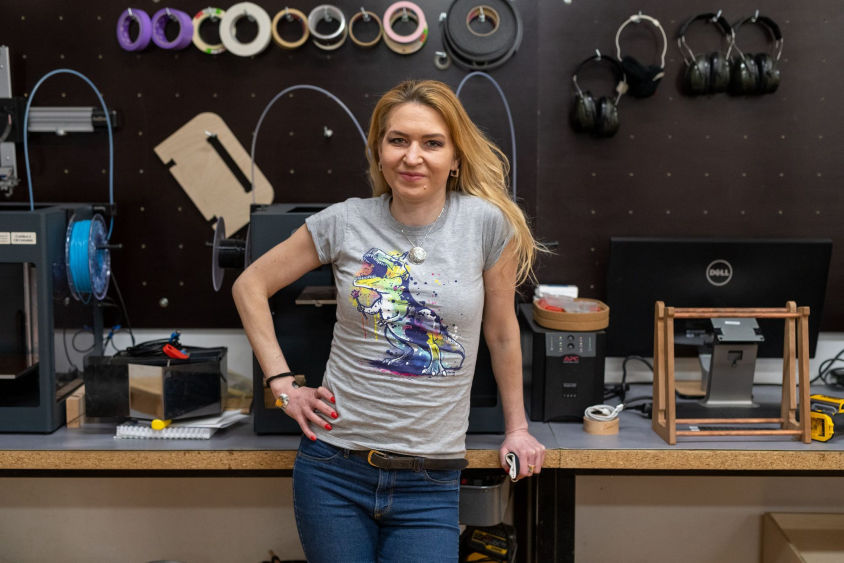
BOLDIZSAR ZSUZSANNA
Hungary
Zsuzsa Boldizsár has always been captivated by the feeling of ‘flow’ when she is completely immersed, absorbed in the creative process. This meditative state is extremely inspiring to her – in addition to the multitude of expression possibilities arising from ceramics.
She experiments a lot with pieces that combine traditions of porcelain making and those of decorative embroidery, which are intensely present in her own family traditions. Her pierced and embroidered items are items located at the border of everyday objects and works of fine art. In her latest works, she has been researching the technical possibilities of porcelain making: for example, she was able to implement dying material between the single porcelain layers using a unique method developed by herself.
These traditional Hungarian folk motifs adorn her works. The contrast between the smooth porcelain and the stylised folk elements creates exciting, charming and immediately likeable objects. They fit into our modern environment and at the same time reminds us of old, rich traditions .
Artist website

EMELIA HILTNER
U.S.A.
Emelia studied ceramics at New York University and the Appalachian Center for Craft. Currently based in Portland, Oregon, she runs a small business selling her functional ceramics.
Her designs are inspired by finding joy in the small moments of life, and she feels honoured for her pieces to live in people’s homes and to be part of their everyday rituals of food and drink. Emelia lived in Hungary when she was a child, and she is exploring her roots with Hungarian culture and life.
Artist website

SIMON HOLPERT
France / Hungary
I essentially think in series, but there is always spontaneity, an active conversation with the material. My series are based on different themes. During Covid, I made Blue Moon, with a new type of clay and glaze. It’s about love and longing, it has the sky and stars in it. The Missing Part series without glaze is about absence, about someone being gone, and how we can get back to touch.
One of the most essential aspects of my work is that I rarely use glaze. I want to bring the importance of touch back, to start feeling the material again. It’s also particularly important to me because, although I’ve turned to sculpture, I don’t want my work to end up in a display case, where it can’t be touched like museum objects. Rather, I want people to live with the artwork. After all, an art object is almost a pet. You don’t have to walk it, you don’t have to feed it, but you can have a relationship with it. Glaze also covers up any imperfections, but I don’t want to cover anything up. Here is what came out of my brain and my hands in the raw.
Born and raised in Paris, he fell in love with the arts at an early age, initially collecting postcards from museums and old lithographs. He studied philosophy, languages and geopolitics, before opening a gallery in Vienna. A chance encounter with the artist Lise Mellian, , changed his life, as he began to explore the world of ceramics and tame porcelain. Staying true to his Hungarian roots, he decided to move to Budapest in 2019; he has been living and working here since then.

MÁRTA JAKOBOVITS
Romania
“The instinctive, sensory way of touching and feeling clay connects me strongly to the primal messages of the material.
Ceramics is such a special means of approaching the deep secrets of our existence, for me, ceramics is a special language. Through this special language of clay, I try to understand myself as a human being and my relationship with nature. There is an ongoing intention to place the resulting shapes and families of shapes in a personal context with natural objects and materials or even directly in natural environment. There is a constant dialogue with the nature around me.
I am driven by a strong curiosity – I carry out endless research on materials and glazes, using different techniques, processing possibilities and allowing the results to generate new forms, new ideas.”
Marta Jakobovits is a professional ceramist, graduated from the Academy for Visual Arts in Cluj and received her PhD. in Liberal Arts from the University of Arts and Design in Budapest. She had been inducted into the Hungarian Academy of Arts, in Budapest in 2005. She works as a free-lanced artist. She gives lectures and leads workshops about ceramics and paper-art at universities as invited artist.
Artist website

KOVÁCS MÁTÉ
Hungary
Máté Kovács's ever-renewing small-batch unique ceramic and porcelain product collection are created in his workshop in addition to fine art projects and functional ceramics.
Tea ceramics, tableware, and various home furnishings are made using traditional ceramic techniques. Each piece is individually thrown or handbuilt from porcelain or stoneware and fired at high temperature. In every case, Máté strives to ensure that his objects are lovable, and that they fulfill their function perfectly.
Their atmosphere is dominated by closeness to nature, lightness, and earthy colors.
Artist website

MONORI ANITA
Hungary
Porcelain designer Anita Monori reflected the reviving fashion of distilling brandy and her objects refresh the old folk pottery tradition of brandy bottles and boutiques. The object form evoke the raw materials of alcoholic spirits and the shapes of his traditional fruits – plums, peaches, pears, cherries added to imaginative graphic decoration and gold lustre.
” In 3D printing one of the most interesting things for me is the way the forms are built up and developed, these sub-processes can result in interesting variations. 3D printed objects can also be incorporated into the process of ceramics making, for example, by using them as model for mould making or as material composites. Used on their own, they are ideal for prototyping."
Using the printed pieces and surfaces as part of the master model, and then taking negative moulds from these, the final porcelain objects are made by slipcasting.
Artist website

RADICS MÁRTA
Hungary
I completed my studies in Budapest at the ceramics department of the Hungarian Academy of Arts. After graduating from university, I lived in Sweden with my family, where I had the opportunity to work in ceramics in Röback in the "Forma" ceramics group. Later I lived in Austria, where mainly drawing and porcelain object design played a significant role. In 2001, I moved to Miskolc, where I have been involved in art education for 18 years. I completed my teaching studies at the Hungarian University of Fine Arts in 2010. In addition to art education, I do continuous creative work, which I represent at domestic and foreign exhibitions and competitions.
When creating my sculptures, I build from different geometric spatial elements, which technical tool offers me endless possibilities of variation. As an innovative and exciting experiment, I provide the regular building units with a spontaneous and unpredictable surface, the depth and richness of the texture of which surfaces can also function as an independent form. By "destroying" the regular square elements on the surface, I get an exciting game of form. The shape-forming effect of surfaces creates many variations between positive and negative forms, which often results in a dramatic effect. In this way, I can reflect with a rich toolbox to express the concepts associated with human existence.
Kápolna u.11,
Kecskemét 6000
Hungary
Phone:
+36 76 486867
Steve Mattison: icshu@me.com
Erika Sütő: studiovezeto@kkmm.hu
NKS Office: icshu@t-online.hu
SUBSCRIBE
Iratkozzon fel a magyar hírlevélre
FELIRATKOZÁS